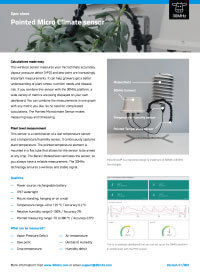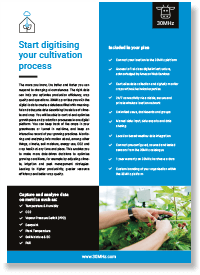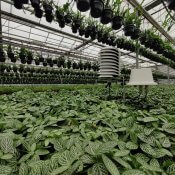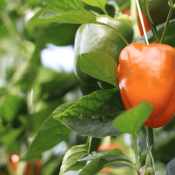Cultivation variables explained: growing degree units
In this blog, we would like to tell you something about growing degree units (GDH / GDD). The reason we added this to our dashboard is that during a lot of conversations our users often ask for this. Degree hour insights are used to pro-actively control cultivation. Growers however indicate that the calculation is time-consuming because it’s done manually and is only available on their PC on which the calculation is performed.
Growing degree units already is a proven concept. What is new, however, is that you can now view this metric in real-time on the 30MHz platform. Even if you are in the middle of a crop walk. And you can combine this information with the insights of all your other crop level data.
Calculating growing degree hours and days
But what exactly are growing degree units? GGH or GDD are calculated based on temperature and used to predict the development of plants or insects. This way you can estimate when your crop will be in bloom or assess how pests or your IPM is developing. You basically optimise the timing of your crops or biological pest control.
We use a threshold value when calculating degree units. The threshold value is the temperature below which you do not expect  crop development. This threshold value is specific to a crop or pest. For degree hours you use the average temperature of one hour. For degree days you use the average 24-hour temperature. You subtract the threshold from the average temperature for the calculation, if it is 0 or lower you have 0 degree units. If your average hourly temp is 2 degrees above your threshold, you have 2 degree hours, and at 10 degrees above the threshold, you have 10 degree hours. Those degree hours are added together.
crop development. This threshold value is specific to a crop or pest. For degree hours you use the average temperature of one hour. For degree days you use the average 24-hour temperature. You subtract the threshold from the average temperature for the calculation, if it is 0 or lower you have 0 degree units. If your average hourly temp is 2 degrees above your threshold, you have 2 degree hours, and at 10 degrees above the threshold, you have 10 degree hours. Those degree hours are added together.
Cold nights during spring
You can imagine that this can lead to a difference especially on clear cold nights during spring: if you use the average temperature of a 24-hour period, you may not exceed your threshold value. If you now calculate the average temperature per hour, you will see that you do not reach the threshold at night, but a number of sunny hours in the middle of the day can indeed exceed the threshold.
If you already work with degree days and have experience with this, I advise you to continue with this. If you are going to start using growing degrees now, use degree hours are easier to use and interpret, because this is more accurate.
Pointed Micro Climate sensor

This sensor uses leaf temperature and temperature humidity measurements to continuously capture microclimate at close range. Use data from the sensor to better determine heating needs, cutting unnecessary energy expenditures and lowering the risk of plant fungus and disease.
A lot of our customers use this sensor for measuring VPD and dew point.
Chill units
In the widget you will see that there is also an option for chill units. Here the threshold is not a lower limit, but an upper limit. You add the period below the threshold value here. Chill Units (CU) are generally used for fruit trees and flower bulbs. Fruit-bearing trees need a period of cold weather after which a fruit-bearing tree will blossom (also known as a vernalization requirement), as do flower bulbs need a cold period for sprouting or bloom. Fruit trees need to spend a specific amount of hours below a threshold temperature to break dormancy so they will flower and set fruit normally.

Chill units is the calculation of the period of cold temperature exposure. The calculation of chill hours in our dashboard is done by counting the hours below a certain threshold. [note, GDH counts the hour times the temperature above a threshold, CU counts the hours below a threshold] During the cold temperatures the plant and flower buds are in a dormant state until they have accumulated sufficient chilling units (CU). When enough CU have accumulated, the flower buds are ready to grow in response to high temperatures.
How you set up the widget
If you use the 30MHz dataplatform, it is easy to set up the widget for GDU. To do this, navigate to “add widget” at the top right of the dashboard. You will find the widget at the bottom, after which you have to fill in a number of fields. In the video at the top of this blog, our colleague Mirjam Bekker explains in detail how to do this.
Start digitising your cultivation process
 The more you know, the better and faster you can respond to changing circumstances. The right data can help you optimise production efficiency, crop quality and operations.
The more you know, the better and faster you can respond to changing circumstances. The right data can help you optimise production efficiency, crop quality and operations.
30MHz Digital Connect provides you with the digital tools to create a database filled with meaningful and adequate data describing the status of climate and crop. You will be able to control and optimise growth plans and production processes in one digital platform.


30MHz is typing… Our extended support team is ready to chat!
At 30MHz we think it’s important that our users can use our platform in an optimal way. At times you may have questions and you would like some help from our support team. Email and our support page filled with helpful articles were your go to’s. But we thought it was time for something extra… ...Read more
New 30MHz connect casing: How we protect your tech
To make sure your dataflow is fully protected, 30MHz introduces a new connect casing: waterproof, dust proof and even resistant to hits. This special shield will last longer and ensure a reliable dataflow from the connected sensor. What does that full protection mean? That’s what we will explain in this article. Watertight: resistant to wetness ...Read more
Smart assistant at work
After the launch of the smart (AI) assistant at GreenTech, the first growers have started using this new feature. The assistant helps them gain insights from their data faster and supports daily decision-making in the greenhouse. Growers report that they use the assistant for: Calculating differences in water content throughout the day Quickly identifying trends ...Read more


